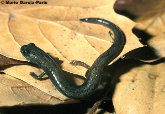Desert Slender Salamander (Batrachoseps aridus)
Description: This is relatively long-legged, broad-headed slender slamander. The tail is short. There are usually 16 to 19 costal grooves. The dorsal surfaces contain silver and copper flecks of pigment, giving adults a pale gray, whitish, or pinkish coloration. The underside of the tail is tan that contrasts with the dark belly. The subadults are black to dark brown above, often with little or no frosty to copper tinge. The broad head, long limbs,and ususally silvery to grayish tinge on the dorsal surfaces distinguish this slender salamander from others.
Habitat: B.m. aridus inhabits a moist cliff and the talus beneath it, as well as associated springs at the oasis. The cliff has a year-round seep covered in Maidens-Hair Fern, and shaded by California Fan Palms and Willow trees. The habitat surrounding the canyon is dry sonoran desert scrub.
Salamander sites are shaded and do not get much direct sunlight.
Range: Endemic to California. B.m. aridus has one of the most limited geographic distributions of any North American amphibian. So far it is only known from two localities on the east slope of the Santa Rosa Mountains: Hidden Palm Canyon (a tributary to Deep Canyon) at an elevation of 2,800 feet and Guadalupe Canyon, about 4.5 miles (by air) to the south-east. The numbers of salamanders found at a given locality within Guadalupe Canyon have been fewer than those found in Hidden Palm Canyon.
Found in these States:
CA
Diet: Most likely eats a variety of small invertebrates. Salamanders have been observed feeding at night capturing small insect with their projectile tongue.
Reproduction: Reproduction is terrestrial. Little is known of the reproductive habits of this salamander. Females of other Batrachoseps species lay eggs in moist places on land. It is presumed that eggs are laid in deep moist limestone crevices. Young develop completely in the egg and hatch fully formed.
Status: Because of the very limited distribution, this animal is considered to be endangered on the state and federal level.
Taxonomy: On 2-6-2024 Batrachoseps major aridus was changed to be Batrachoseps aridus.
»» Kingdom: Animalia - Animals
»» Phylum: Chordata - Chordates
»» Subphylum: Vertebrata - Vertebrates
»» Class: Amphibia - (Amphibians)
»» Order: Caudata - Salamanders
»» Family: Plethodontidae - Lungless Salamanders
»» Genus: Batrachoseps
»» Species: Batrachoseps major - California Slender Salamander
»» Subspecies: Batrachoseps aridus - Desert Slender Salamander
This article uses material from the Wikipedia article "Garden Slender Salamander", which is released under the Creative Commons Attribution-Share-Alike License 3.0. Content may have been omitted from the original, but no content has been changed or extended.
|









